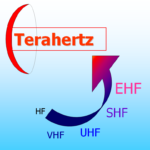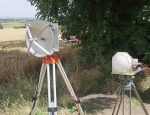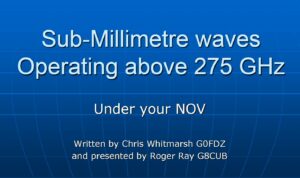Terahertz
Amateur NoV Access to >275 GHz – Terahertz Innovation
 Ofcom have generously enabled NoV access for Full Licensees in order to facilitate innovation at the cutting edge of rf technology. The NoV includes a number of frequency band conditions based on ITU-RR5.565, including protection zones around key UK Radio Astronomy Sites. Guidance on this is available below:-
Ofcom have generously enabled NoV access for Full Licensees in order to facilitate innovation at the cutting edge of rf technology. The NoV includes a number of frequency band conditions based on ITU-RR5.565, including protection zones around key UK Radio Astronomy Sites. Guidance on this is available below:-
- Guidance for the NoV, permitted bands, propagation and RR5.565
- Online Map of UK Radio Astronomy Sites and their 20km protection radii
- Application form for the NoV
Note: The NoV is a temporary one. Applicants also need to specify operating locations, such as preferred hilltops, beforehand (similar to the 2300-2302MHz NoV).
Terahertz Background
 Terahertz frequencies, also known as sub-millimetre waves is spectrum in the 300GHz-3THz range. This aligned with the ITU Radio Regulations that have an upper limit of 3THz.
Terahertz frequencies, also known as sub-millimetre waves is spectrum in the 300GHz-3THz range. This aligned with the ITU Radio Regulations that have an upper limit of 3THz.
In the UK the Wireless Telegraphy Act implements the ITU top limit and applies to all apparatus up to 3000 GHz (3THz). It is only frequencies above 3THz which are free of regulation – for comparison Red light is ~400THz.
In practice the ITU split this into two sub ranges, both of which are controlled by ITU Radio Regulation footnote 5.565.
- 275-1000GHz – where important sub-bands for passive services are identified
- 1000-3000GHz – where there is more flexibility
In the UK, as there is no general exemption, transmissions in the 275GHz – 3THz range thus requires some form of licence. Licensed Amateurs in the USA and Germany also have some access based on their own national regulations.
Part of this frequency range (275-450 GHz) was studied by WRC-19 Agenda Item 1.15. This added a series of fixed and land mobile service frequency identifications under newer footnote 5.564A .
WRC-31 has a preliminary agenda item to introduce formal allocations within the range 275-325GHz, including consideration of the amateur and amateur satellite service.
Please keep the Society updated with any developments and achievements, as that is helpful to update Ofcom.
This recent slide set on operating above 275 GHz by Chris Whitmarsh G0FDZ and Roger Ray G8CUB gives a great overview of UK Amateur Terahertz developments which have been around 288GHz, as well as other international work.
- UK: Operating at 288GHz / Terahertz – UK Microwave Group (UKuG)
- ITU: Terahertz Trends Report (ITU-R SM.2352)











